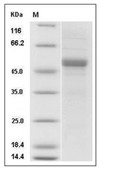Shopping Cart
- Remove All
 Your shopping cart is currently empty
Your shopping cart is currently empty

Apolipoprotein M/APOM Protein, Human, Recombinant (hFc) is expressed in HEK293 mammalian cells with hFc tag. The predicted molecular weight is 45.6 kDa and the accession number is O95445.

| Pack Size | Price | Availability | Quantity |
|---|---|---|---|
| 50 μg | $320 | In Stock | |
| 100 μg | $547 | 7-10 days | |
| 200 μg | $935 | 7-10 days | |
| 500 μg | $1,890 | 7-10 days |
| Biological Activity | Activity testing is in progress. It is theoretically active, but we cannot guarantee it. If you require protein activity, we recommend choosing the eukaryotic expression version first. |
| Description | Apolipoprotein M/APOM Protein, Human, Recombinant (hFc) is expressed in HEK293 mammalian cells with hFc tag. The predicted molecular weight is 45.6 kDa and the accession number is O95445. |
| Species | Human |
| Expression System | HEK293 Cells |
| Tag | C-hFc |
| Accession Number | O95445 |
| Synonyms | NG20,HSPC336,G3a,DADB-127H9.5,apo-M,apolipoprotein M |
| Construction | A DNA sequence encoding the human APOM (O95445) (Met 1-Asn 188) was fused with the Fc region of human IgG1 at the C-terminus. Predicted N terminal: Cys 23 |
| Protein Purity | > 85 % as determined by SDS-PAGE  |
| Molecular Weight | 45.6 kDa (predicted); 50 kDa (reducing condition, due to glycosylation) |
| Endotoxin | < 1.0 EU/μg of the protein as determined by the LAL method. |
| Formulation | Lyophilized from a solution filtered through a 0.22 μm filter, containing PBS, pH 7.4. Typically, a mixture containing 5% to 8% trehalose, mannitol, and 0.01% Tween 80 is incorporated as a protective agent before lyophilization. |
| Reconstitution | A Certificate of Analysis (CoA) containing reconstitution instructions is included with the products. Please refer to the CoA for detailed information. |
| Stability & Storage | It is recommended to store recombinant proteins at -20°C to -80°C for future use. Lyophilized powders can be stably stored for over 12 months, while liquid products can be stored for 6-12 months at -80°C. For reconstituted protein solutions, the solution can be stored at -20°C to -80°C for at least 3 months. Please avoid multiple freeze-thaw cycles and store products in aliquots. |
| Shipping | In general, Lyophilized powders are shipping with blue ice. |
| Research Background | ApoM (apolipoprotein M) is an apolipoprotein and member of the lipocalin protein family. The lipocalins share limited regions of sequence homology and a common tertiary structure architecture. They have an eight-stranded, antiparallel, symmetrical _-barrel fold, which is in essence a beta sheet which has been rolled into a cylindrical shape. Inside this barrel is located a ligand binding site. They transport small hydrophobic molecules such as steroids, bilins, retinoids, and lipids. Lipocalins have been associated with many biological processes, among them immune response, pheromone transport, biological prostaglandin synthesis, retinoid binding, and cancer cell interactions. Lipocalins are comparatively small in size, and are thus less complicated to study as opposed to large, bulky proteins. They can also bind to various ligands for different biological purposes. ApoM is associated with high density lipoproteins and to a lesser extent with low density lipoproteins and triglyceride-rich lipoproteins. ApoM is involved in lipid transport and can bind sphingosine-1-phosphate, myristic acid, palmitic acid and stearic acid, retinol, all-trans-retinoic acid and 9-cis-retinoic acid. |

Copyright © 2015-2025 TargetMol Chemicals Inc. All Rights Reserved.